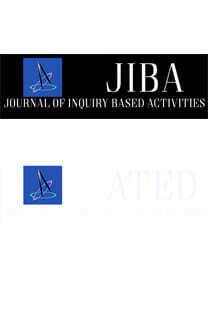PROJE TABANLI STEM ETKİNLİĞİ: OKULUMUZUN BAHÇESİNE MİNİ BİR ÇİFTLİK KURALIM
A PROJECT BASED STEM ACTIVITY: LET'S BUILD A MINI FARM ON OUR SCHOOLYARD
___
Adanır, Y. (2021). Proje tabanlı STEM eğitiminin 7. sınıf öğrencilerinin bilimsel okuryazarlıklarına ve üretici düşünme becerilerine etkisi [Yayımlanmamış yüksek lisans tezi]. Giresun Üniversitesi.Bell, S. (2010). Project-based learning for the 21st century: Skills for the future. The Clearing House, 83(2), 39-43.
Blair, D. (2009). The child in the garden: An evaluative review of the benefits of school gardening. Journal of Environmental Education, 40(2), 15–38.
Bozkurt Altan, E., & Hacıoğlu, Y. (2019). Fen bilimleri öğretmenlerinin derslerinde STEM odaklı etkinlikler gerçekleştirmek üzere geliştirdikleri problem durumlarının incelenmesi. Necatibey Eğitim Fakültesi Elektronik Fen ve Matematik Eğitimi Dergisi, 12(2), 487- 507.
Breiner, J. M., Harkness, S. S., Johnson, C. C., & Koehler, C. M. (2012). What is STEM? A discussion about conceptions of STEM in education and partnerships. School Science and Mathematics, 112(1), 3-11.
Bybee, R. W. (2013). The case for STEM education: Challenges and opportunities. National Science Teachers Association.
Capraro R. M., & Slough S. W. (2013). Why PBL? Why STEM? Why now? An introduction to STEM project-based learning. In R. M. Capraro, M. M. Capraro, & J. R. Morgan (Eds.), STEM project-based learning (pp. 1-5). Sense Publishers. https://doi.org/10.1007/978- 94-6209-143-6_1
Chen, Y., & Chang, C. C. (2018). The impact of an integrated robotics STEM course with a sailboat topic on high school students’ perceptions of integrative STEM, interest, and career orientation. EURASIA Journal of Mathematics, Science and Technology Education, 14(12), 1614.
Fifolt, M., & Morgan, A. F. (2019). Engaging K-8 students through inquiry-based learning and school farms. Journal of Education for Students Placed at Risk (JESPAR), 24(1), 92-108.
Guzey, S.S., Caskurlu, S. & Kozan, K. (2020). Integrated STEM pedagogies and student learning. In C. C. Johnson, M. J. MohrSchroeder, T. J. Moore & L. D. English (Eds.), Handbook of research on STEM education (pp.65-75). Routledge.
Hacıoğlu, Y., & Başpınar, A. (2020). Bir sınıf öğretmeni ve öğrencilerinin ilk STEM eğitimi deneyimleri. Karadeniz Sosyal Bilimler Dergisi, 12(22), 1-23.
Hacıoğlu, Y., & Dönmez Usta, N. (2020). Digital game design-based STEM activity: Biodiversity example. Science Activities, 57(1), 1-15.
Han, S., Capraro, R., & Capraro, M. M. (2015). How science, technology, engineering, and mathematics (STEM) project-based learning (PBL) affects high, middle, and low achievers differently: The impact of student factors on achievement. International Journal of Science and Mathematics Education, 13(5), 1089– 1113.
Han, S., Rosli R., Capraro, M. M., & Capraro, R. M. (2016). The Effect of science, technology, engineering and mathematics (STEM) project based learning (PBL) on students’ achievement in four mathematics topics. Journal of Turkish Science Education, 13(special), 3-29.
Horton, R. M., Hedetniemi, T., Wiegert, E., & Wagner, J. R. (2006). Integrating curriculum through themes. Mathematics Teaching in the Middle School, 11, 408- 414.
Kwon, H., Capraro, R. M., & Capraro, M. M. (2021). When I believe, I can: Success STEMs from my perceptions. Canadian Journal of Science, Mathematics and Technology Education, 21, 67–85. https://doi.org/10.1007/s42330-020- 00132-4
Milli Eğitim Bakanlığı. (2018). Fen bilimleri dersi öğretim programı (İlkokul ve ortaokul 3, 4, 5, 6, 7 ve 8. sınıflar). https://mufredat.meb.gov.tr/Dosyalar/20 1812312311937- FEN%20B%C4%B0L%C4%B0MLER %C4%B0%20%C3%96%C4%9ERET% C4%B0M%20PROGRAMI2018.pdf
Merrill, C., & Comerford, M. (2004). Technology and mathematics standards: An integrated approach. Technology Teacher, 64, 8-12.
Miller, E., & Krajcik, J. (2019). Promoting deep learning through project-based learning: A design problem. Disciplinary and Interdisciplinary Science Education Research. https://doi.org/10.1186/s43031-019- 0009-6.
National Academy of Engineering and National Research Council. (2014). STEM integration in K-12 education: Status, prospects, and an agenda for research. The National Academies Press.
National Research Council. (2012). A framework for K-12 science education: Practices, crosscutting concepts, and core ideas. The National Academies Press.
Roehrig, G. H., Dare, E. A., Ring-Whalen, E., & Wieselmann, J. R. (2021). Understanding coherence and integration in integrated STEM curriculum. International Journal of STEM Education, 8(2), 1-21.
Schooler, S. R. (2004). A chilling project integrating mathematics, science, and technology. Mathematics Teaching in the Middle School, 10, 116-121.
Selmer S. J., Rye, J. A., Malone, E., Fernandez, D., & Trebino, K. (2014). What should we grow in our school garden to sell at the farmers’ market? Initiating statistical literacy through science and mathematics integration. Science Activities, 51(1), 17- 32.
Tati, T., Firman, H., & Riandi, R. (2017, May 24). The effect of STEM learning through the project of designing boat model toward student STEM literacy. Journal of Physics: Conference Series, 895(1), 012157. IOP Publishing. https://iopscience.iop.org/article/10.108 8/1742-6596/895/1/012157/pdf
Thomas, J. W. (2000). A review of research on PBL. The Autodesk Foundation. https://www.asec.purdue.edu/lct/HBCU/ documents/AReviewofResearchofProjec t-BasedLearning.pdf
Wan, Z. H., So, W. M. W., & Zhan, Y. (2020). Developing and validating a scale of STEM project-based learning experience. Research in Science Education, 1-17. https://doi.org/10.1007/s11165-020- 09965-3
Wendell, K. B., Connolly, K. G., Wright, C. G., Jarvin, L., Rogers, C., Barnett, M., & Marulcu, I. (2010, June 20-23). Incorporating engineering design into elementary school science curricula [Poster session]. American Society for Engineering Education Annual Conference & Exposition, Louisville, KY, United States.
Wilhelm, J., Wilhelm, R., & Cole, M. (2019). Creating project-based STEM environments. Springer.
Williams, D. R., & Dixon, P. S. (2013). Impact of garden-based learning on academic outcomes in schools: Synthesis of research between 1990 and 2010. Review of Educational Research, 83(2), 211– 235.
Yıldırım, B., & Selvi, M. (2017). STEM öğretme-öğrenme modelleri: 5E öğrenme model, proje tabanlı öğrenme yaklaşımı ve STEM SOS modeli. S. Çepni (Ed.), Kuramdan uygulamaya STEM eğitimi içinde (pp. 203-238). Pegem.
- ISSN: 2146-5711
- Yayın Aralığı: 2
- Başlangıç: 2011
- Yayıncı: Mustafa ÇAKIR
PROJE TABANLI STEM ETKİNLİĞİ: OKULUMUZUN BAHÇESİNE MİNİ BİR ÇİFTLİK KURALIM
Yasemin ADANIR, Yasemin HACIOĞLU
Muhammed Fatih KÜÇÜKKARA, Pelin AKSÜT
ÖZEL GEREKSİNİMİ OLAN ÖĞRENCİLER İÇİN BİR ROL MODEL ÇALIŞMASI
Seval ÖZBALCI, Özge BALIK, Turan GÜNDÜZ
ASAL SAYILARIN ÖĞRETİMİNDE ALTERNATİF BİR MATERYAL: ASAL ÇARPAN KARTELÂSI
ASSURE MODELİNE DAYALI BİR FEN MODÜLÜ ÖNERİSİ: POTANSİYEL ENERJİ
